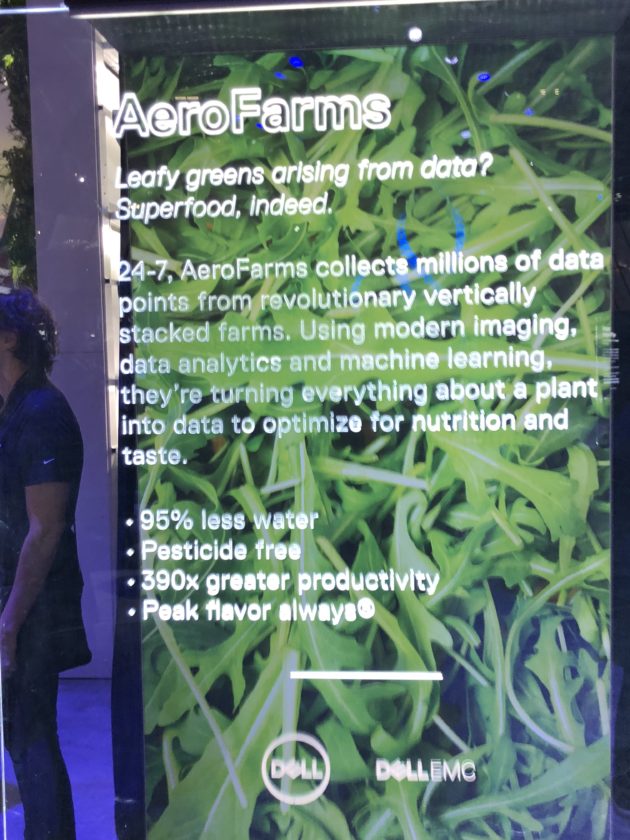
by Gary Mintchell | Nov 27, 2019 | Data Management, Manufacturing IT, Operations Management
This announcement hits many trends and things you will eventually grow tired of hearing—partnerships, collaboration among companies, ecosystems, Kubernetes, containers, and, yes, 5G. The latter is coming. We just don’t know when and how, yet.
Wind River, a leader in delivering software for the intelligent edge, announced that it is collaborating with Dell EMC as a key hardware partner for distributed edge solutions. A combined software and hardware platform would integrate Wind River Cloud Platform, a Kubernetes-based software offering for managing edge cloud infrastructure, with Dell EMC PowerEdge server hardware. The initial target use case will be virtual RAN (vRAN) infrastructure for 5G networks.
“As telecom infrastructure continues to evolve, service providers are facing daunting challenges around deploying and managing a physically distributed, cloud native vRAN infrastructure,” said Paul Miller, vice president of Telecommunications at Wind River. “By working with Dell EMC to pre-integrate our technologies into a reference distributed cloud solution, we can cost-effectively deliver carrier grade performance, massive scalability, and rapid service instantiation to service providers as their foundation for 5G networks.”
“In a 5G world, new services and applications will not be driven by massively scaled, centralized data centers but by intelligently distributed systems built at the network edge,” said Kevin Shatzkamer, vice president of Enterprise and Service Provider Strategy and Solutions at Dell EMC. “The combination of Dell EMC and Wind River technology creates a foundation for a complete, pre-integrated distributed cloud solution that delivers unrivaled reliability and performance, massive scalability, and significant cost savings compared to conventional RAN architectures. The solution will provide CSPs with what they need to migrate to 5G vRAN and better realize a cloud computing future.”
Wind River Cloud Platform combines a fully cloud-native, Kubernetes and container-based architecture with the ability to manage a truly physically and geographically separated infrastructure for vRAN and core data center sites. Cloud Platform delivers single pane of glass, zero-touch automated management of thousands of nodes.
Dell EMC hardware delivers potent compute power, high performance and high capacity memory is well suited to low-latency applications.
A commercial implementation of the open source project StarlingX, Cloud Platform scales from a single compute node at the network edge, up to thousands of nodes in the core to meet the needs of high value applications. With deterministic low latency required by edge applications and tools that make the distributed edge manageable, Cloud Platform provides a container-based infrastructure for edge implementations in scalable solutions ready for production.

by Gary Mintchell | Jul 27, 2018 | Internet of Things, Organizations
Platforms that serve to expedite the interaction and collaboration of apps in the Internet of Things (IoT) are sort of the next new thing. There are several that some of the IT analyst firms are following. Trouble is the term allows for a wide variety.
One I’ve written about several times here and here and here is open source developed under the auspices of the Linux Foundation with major leadership and contributions by Dell Technologies. It’s called the EdgeX Foundry. The initiative includes 47 member companies.
The second major release of the platform (California) has just seen the light of day. I picked up information from a blog post by Jim White, Vice Chair of the Technical Steering Committee and Distinguished Engineer and Project Lead of the IoT Platform Development Team within Dell Technologies IoT Solutions Division.
Following is a lightly edited version of his blog concerning the announcement.
While EdgeX is only a year old, our community is demonstrating its staying power with the second major release in its first year. The California release, which follows Barcelona, shows the commitment and dedication of many who see the importance and potential of developing a flexible, open source, IoT software platform for the edge that provides connectivity and interoperability while still allowing value add.
So, what is new with the California release? A lot! But before we get into the details, I want to highlight that the biggest focus of this release was to introduce a few key security capabilities and to make EdgeX smaller and faster.
Security
EdgeX began its existence without security and organizations wanting to leverage the platform had to add their own security capability. Today, EdgeX incorporates some of the first security elements. These initial elements, while useful on their own, are essential building blocks to additional security features in the future.
The first security elements include a reverse proxy that helps protect the REST API communications and a secrets store. With the EdgeX reverse proxy in place – as provided by incorporating an open source product called Kong – any external client of an EdgeX micro service must first authenticate themselves before successfully calling on an EdgeX API.
The secure storage facility was provided by incorporating the open source Vault (Hashicorp) product, and it allows items such as username/password credentials, certificates, secure tokens, etc. to be persisted and protected within EdgeX. These types of “secrets” will allow EdgeX to, for example, encrypt data, make HTTPS calls to the enterprise, or connect EdgeX to a cloud provider in a secure manner.
Performance and Scalability
The EdgeX Foundry Technical Steering Committee decided early last year in the project’s formation that we would release twice a year – once in April and once in October. You probably noticed that it’s not April.
Last year, we decided that EdgeX needed to be smaller and faster to better function effectively at “the edge”, which the largely-Java code from the seed donation was going to make difficult. To do this, we needed to rebuild the EdgeX microservices in Go Lang – and do so by our spring 2018 release. This was not a small endeavor and it was made at a time when the EdgeX Foundry developer community was just coming on board. We knew it would take a bit more time, but we were committed to this, and added two more months to this release cycle.
The extra time was well worth it! With the California release, we’ve dramatically lowered the footprint, startup time, memory and CPU usage. Take a look at the statistics below, which compares services from our first community release last October (Barcelona) to our current release (California).

We still have work to do, but it’s now possible to run all of EdgeX on something like a Raspberry Pi 3.
Additional Features
In addition to the initial security capabilities and reducing the size and latency of the platform, this release includes other work – some visible to the user while some features are more hidden but improve the overall quality of EdgeX.
• Several additions were made to the export services to provide additional “northbound” connectivity, to include connectors for XMPP, ThingsBoard IoT, and Brightics IoT
• We improved the documentation and now have documentation stored with the code in Github – allowing it to be maintained and updated more like code by the community
• Arm 64 is now fully supported. In fact we worked with the Linux Foundation to add external environments and tools to create native Arm 64 artifacts.
• We added blackbox tests for all the micro services. These are now kicked off as part of our build and continuous integration processes.
• Other improvements were made to our continuous integration – to help streamline developer contributions
On to Delhi
Our next release, named Delhi, will come out in October 2018. Due to the extended release cycle for California, the Delhi release cycle is going to be short. The significant features planned for Delhi include:
• Initial manageability services and capability
• Device Service SDKs (Go/C) and at least one example device service
• The next wave of security features to include access control lists to grant access to appropriate services and improved security service bootstrapping
• Better/more unit testing and added performance testing
• Adding the last of the refactored and improved Go Lang microservices
• Outlining options and a potential implementation plan for alternate or additional database support
• An EdgeX UI suitable for demos and smaller installations

by Gary Mintchell | May 24, 2018 | News, Technology
Living with technology a decade from now. Dell Technologies and the Institute for the Future conducted an in-depth discussion with 20 experts to explore how various social and technological drivers will influence the next decade and, specifically, how emerging technologies will recast our society and the way we conduct business by the year 2030.
There is no universally agreed upon determination of which technologies are considered emerging. For the purpose of this study, IFTF explored the impact that Robotics, Artificial Intelligence (AI) and Machine Learning, Virtual Reality (VR) and Augmented Reality (AR), and Cloud Computing, will have on society by 2030. These technologies, enabled by significant advances in software, will underpin the formation of new human-machine partnerships, according to the IFTF.
Talk of digital transformation is virtually everywhere in Information Technology circles and Operations Technology circles. My long and varied experiences have often placed me at the boundaries where the two meet—and are now increasingly overlapping.
The take on robotics is right on target. And forget about all the SciFi scare stories that mainstream media loves to promote. The future is definitely all about human-machine partnership or collaboration. For example I often talk with EMTs about life in the rescue squad. These people are always in the gym. Our population in the US has gotten so large and obese that they often have to lift 300+ lb. people who haven’t the strength to help themselves up. Think about a robot assistant helping the EMT.
The AI discussion is also fraught with prominent people like Ray Kurzweil or Elon Musk giving dystopian SciFi views of the future. We are a long way from “intelligence.” Where we are is really the use of machine learning and neural networks that help machines (and us) learn by deciphering recurring patterns.
Back to the study, the authors state, “If we start to approach the next decade as one in which partnerships between humans and machines transcend our limitations and build on our strengths, we can begin to create a more favorable future for everyone.”
Jordan Howard, Social Good Strategist and Executive Director of GenYNot, sees tremendous promise for the future of human-machine partnerships: “Many of the complex issues facing society today are rooted in waste, inefficiency, and simply not knowing stuff, like how to stop certain genes from mutating. What if we could solve these problems by pairing up more closely with machines and using the mass of data they provide to make breakthroughs at speed? As a team, we can aim higher, dream bigger, and accomplish more.”
Liam Quinn, Dell Chief Technology Officer, likens the emerging technologies of today to the roll-out of electricity 100 years ago. Quinn argues that we no longer fixate on the “mechanics” or the “wonders” of electricity, yet it underpins almost everything we do in our lives. Similarly, Quinn argues, in the 2030s, today’s emerging technologies will underpin our daily lives. As Quinn provokes, “Imagine the creativity and outlook that’s possible from the vantage point these tools will provide: In 2030, it will be less about the wonderment of the tool itself and more about what that tool can do.”
By 2030, we will no longer revere the technologies that are emerging today. They will have long disappeared into the background conditions of everyday life. If we engage in the hard work of empowering human-machine partnerships to succeed, their impact on society will enrich us all.
Robots
While offshoring manufacturing jobs to low-cost economies can save up to 65% on labor costs, replacing human workers with robots can save up to 90% of these costs.
China is currently embarking upon an effort to fill its factories with advanced manufacturing robots, as workers’ wages rise and technology allows the industry to become more efficient. The province of Guangdong, the heartland of Chinese manufacturing, has promised to invest $154 billion in installing robots.
Buoyed by their commercial success, the adoption of robots will extend beyond manufacturing plants and the workplace. Family robots, caregiving robots, and civic robots will all become commonplace as deep learning improves robots’ abilities to empathize and reason. Google recently won a patent to build worker robots with personalities.
Artificial Intelligence and Machine Learning
Approximately 1,500 companies in North America alone are doing something related to AI today, which equates to less than 1% of all medium-to-large companies. We’re seeing this in the financial services industry already, with data recognition, pattern recognition, and predictive analytics being applied to huge data sets on a broad scale. In a 2015 report, Bank of America Merrill Lynch estimated that the AI market will expand to $153 billion over the next five years—$83 billion for robots, and $70 billion for artificial intelligence-based systems.
In addition to their ability to make decisions with imperfect information, machines are now able to learn from their experiences and share that learning with other AI programs and robots. But AI progress also brings new challenges. Discussions surrounding who or what has moral and ethical responsibility for decisions made by machines will only increase in importance over the next decade.
Virtual Reality and Augmented Reality
Although both Virtual and Augmented Reality are changing the form factor of computing, there is a simple distinction between the two. VR blocks out the physical world and transports the user to a simulated world, whereas AR creates a digital layer over the physical world.
Despite the difference, both technologies represent a fundamental shift in information presentation because they allow people to engage in what Toshi Hoo, Director of IFTF’s Emerging Media Lab, calls “experiential media” as opposed to representative media. No longer depending on one or two of our senses to process data, immersive technologies like AR and VR will enable people to apply multiple senses—sight, touch, hearing, and soon, taste and smell—to experience media through embodied cognition.
Over the next decade, Hoo forecasts that VR, combined with vast sensor networks and connected technologies, will be one of many tools that enable distributed presence and embodied cognition, allowing people to experience media with all their senses.
Cloud Computing
It’s important to recognize that Cloud Computing isn’t a place, it’s a way of doing IT. Whether public, private, or hybrid (a combination of private and public), the technology is now used by 70% of U.S. organizations. This figure is expected to grow further, with 56% of businesses surveyed saying they are working on transferring more IT operations to the cloud, according to IDG Enterprise’s 2016 Cloud Computing Executive Summary.
While the cloud is not a recent technological advancement, cloud technology only really gathered momentum in recent years, as enterprise grade applications hit the market, virtualization technologies matured, and businesses became increasingly aware of its benefits in terms of efficiency and profitability. Increasing innovation in cloud-native apps and their propensity to be built and deployed in quick cadence to offer greater agility, resilience, and portability across clouds will drive further uptake. Start-ups are starting to use cloud-native approaches to disrupt traditional industries; and by 2030, cloud technologies will be so embedded, memories from the pre-cloud era will feel positively archaic by comparison.
Human Machine Partnership
Recent conversations, reports, and articles about the intersection of emerging technologies and society have tended to promote one of two extreme perspectives about the future: the anxiety-driven issue of technological unemployment or the optimistic view of tech-enabled panaceas for all social and environmental ills.
Perhaps a more useful conversation would focus on what the new relationship between technology and society could look like, and what needs to be considered to prepare accordingly.
By framing the relationship between humans and machines as a partnership, we can begin to build capacity in machines to improve their understanding of humans, and in society and organizations, so that more of us are prepared to engage meaningfully with emerging technologies.
Digital (Orchestra) Conductors
Digital natives will lead the charge. By 2030, many will be savvy digital orchestra conductors, relying on their suite of personal technologies, including voice-enabled connected devices, wearables, and implantables; to infer intent from their patterns and relationships, and activate and deactivate resources accordingly.
Yet, as is often the case with any shift in society, there is a risk that some segments of the population will get left behind. Individuals will need to strengthen their ability to team up with machines to arrange the elements of their daily lives to produce optimal outcomes. Without empowering more to hone their digital conducting skills, the benefits that will come from offloading ‘life admin’ to machine partners will be limited to the digitally literate.
Work Chasing People
Human-machine partnerships will not only help automate and coordinate lives, they will also transform how organizations find talent, manage teams, deliver products and services, and support professional development. Human-machine partnerships won’t spell the end of human jobs, but work will be vastly different.
By 2030, expectations of work will reset and the landscape for organizations will be redrawn, as the process of finding work gets flipped on its head. As an extension of what is often referred to as the ‘gig economy’ today, organizations will begin to automate how they source work and teams, breaking up work into tasks, and seeking out the best talent for a task.
Instead of expecting workers to bear the brunt of finding work, work will compete for the best resource to complete the job. Reputation engines, data visualization, and smart analytics will make individuals’ skills and competencies searchable, and organizations will pursue the best talent for discrete work tasks.

by Gary Mintchell | May 22, 2018 | Internet of Things, Manufacturing IT, Technology
A few of us gathered for a round table discussion of Internet of Things while I was at Dell Technologies World at the beginning of the month. I arrived a little early and had a private round table for several minutes before others arrive and the discussion became broader.
Ray O’Farrell, CTO of VMware and GM of IoT at Dell Technologies, said the focus of last 6 months since the new Internet of Things organization was announced included these three points:
1. Dell is 7 companies, trying to achieve one cohesive strategy across all; one organization when facing customers.
2. Best way is to work within the ecosystem, that is history of VMWare.
3. Building technology and leverage solutions. This is a complex undertaking as not all challenges within IoT are alike—there are few cookie cutter applications.
The evolution of Internet of Things within Dell to Dell EMC to Dell Technologies constitutes an upward spiraling path encompassing the greater breadth of technologies and organization reflecting the post-merger company. When I first came along, the concept was building an ecosystem around selling an edge device appliance. Now the strategy is much broader bringing the goal of IT/OT convergence closer to reality. As I’ve mentioned before, the IT companies are attacking that convergence from the IT side after years of manufacturing/production oriented suppliers trying to accomplish the same thing from the OT side. Maybe like the old country song we’ll meet in the middle someday.
Everyone talks Artificial Intelligence (AI) these days, and Dell Technologies is not exception. However, AI is not the science fiction doom and gloom predicted by Ray Kurzweil, Elon Musk, and others. Mostly it entails machine learning (ML) from detected patterns in the data.
Or as Dell Technologies says, it is applying AI and ML technology to turn data into intelligent insights, drive a faster time to market, and achieve better business outcomes.
News summary
• Dell EMC PowerEdge expands portfolio to accelerate AI-driven workloads, analytics, deployment and efficiency
• Deepens relationship with Intel to advance AI community innovation, machine learning (ML) and deep learning (DL) capabilities with Dell EMC Ready Solutions
• Dell Precision Optimizer 5.0 now enhanced with machine learning algorithms, intelligently tunes the speed and productivity of Dell Precision workstations.
• Dell EMC uses AI, ML and DL to transform support and deployment
14th generation Dell EMC PowerEdge four-socket servers and Dell Precision Optimizer 5.0 are designed to further strengthen AI and ML capabilities.
According to the recently released update of the Enterprise Strategy Group (ESG) 2018 IT Transformation Maturity Curve Index, commissioned by Dell EMC, transformed companies are 18X more likely to make better and faster data-driven decisions than their competition. Additionally, transformed companies are 22X as likely to be ahead of the competition with new products and services to market.
“The Internet of Things is driving an onslaught of data and compute at the edge, requiring organizations to embrace an end-to-end IT infrastructure strategy that can effectively, efficiently and quickly mine all that data into business intelligence gold,” said Jeff Clarke, vice chairman, Products & Operations, Dell. “This is where the power of AI and machine learning becomes real – when organizations can deliver better products, services, solutions and experiences based on data-driven decisions.”
Unlike competitors’ four-socket offerings, these servers also support field programmable gate arrays (FPGAs)3, which excel on data-intensive computations. Both servers feature OpenManage Enterprise to monitor and manage the IT infrastructure, as well as agent-free Integrated Dell Remote Access Controller (iDRAC) for automated, efficient management to improve productivity.
Dell EMC is also announcing its next generation PowerMax storage solution, built with a machine learning engine which makes autonomous storage a reality.
Leveraging predictive analytics and pattern recognition, a single PowerMax system analyzes and forecasts 40 million data sets in real-time per array4, driving six billion decisions per day5 to automatically maximize efficiency and performance of mixed data storage workloads.
The new Dell Precision Optimizer 5.0 uses AI to automatically adjust applications running on Dell Precision workstations to maximize performance by:
• Custom-optimizing applications: Dell Precision Optimizer learns each application’s behavior in the background and uses that data to employ a trained machine learning model that will automatically adjust the system to optimized settings and deliver up to 394% improvement in application performance.
• Automating systems configuration adjustments: Once activated and a supported application is launched, the software automatically adjusts system configurations such as CPU, memory, storage, graphics and operating system settings.
Speaking of partners and collaboration, Dell Technologies and Microsoft join forces to build secure, intelligent edge-to-cloud solution featuring Dell Edge Gateways, VMware Pulse IoT Center, and Microsoft Azure IoT Edge
News summary
• Joint IoT solution helps simplify management, enhances security and help lowers cost of deployment at the edge
• Built on innovative analytics applications, management tools and edge gateways to enable network security from edge devices to the cloud
• Accelerates IoT adoption in industry verticals key to economic growth and development
The joint solution offers an underlying IoT infrastructure, management capabilities, and security for customers looking to deploy IoT for scenarios like predictive maintenance, supply chain visibility and other use cases. The solution will deliver:
• Intelligence at the edge with Microsoft Azure IoT Edge: This application extends cloud intelligence to edge devices so that devices can act locally and leverage the cloud for global coordination and machine learning at scale
• Management and monitoring of edge devices with VMware Pulse IoT Center: This provides more secure, enterprise-grade management and monitoring of diverse, certified edge devices including gateways and connected IoT devices, bios and operating systems. This ecosystem will be built over time involving deeper integration and certification to support customer requirements.
• High-performance, rugged Dell Edge Gateways: IoT devices with powerful dual-core Intel® Atom™ processors connect a variety of wired and wireless devices and systems to aggregate and analyze inputs and send relevant data to the cloud
VMware Pulse IoT Center will serve as the management glue between the hardware (Dell Edge Gateways or other certified edge systems), connected sensors and devices and the Microsoft Azure IoT Edge. Initially, Pulse will help to deploy the Microsoft Azure IoT Edge to the requisite edge systems so that it can start collecting, analyzing and acting on data in real-time.
by Gary Mintchell | May 10, 2018 | Data Management, Internet of Things, News
Much time was devoted last week at Dell Technologies World to Dell’s Legacy of Good highlighting people and companies doing some really cool and worthwhile things. I’m especially impressed with the AeroFarms people (see photos below) who are using IoT to find a better way to grow wholesome vegetables. Hey engineers–maybe there’s a thought in here to spark your next creative interest.
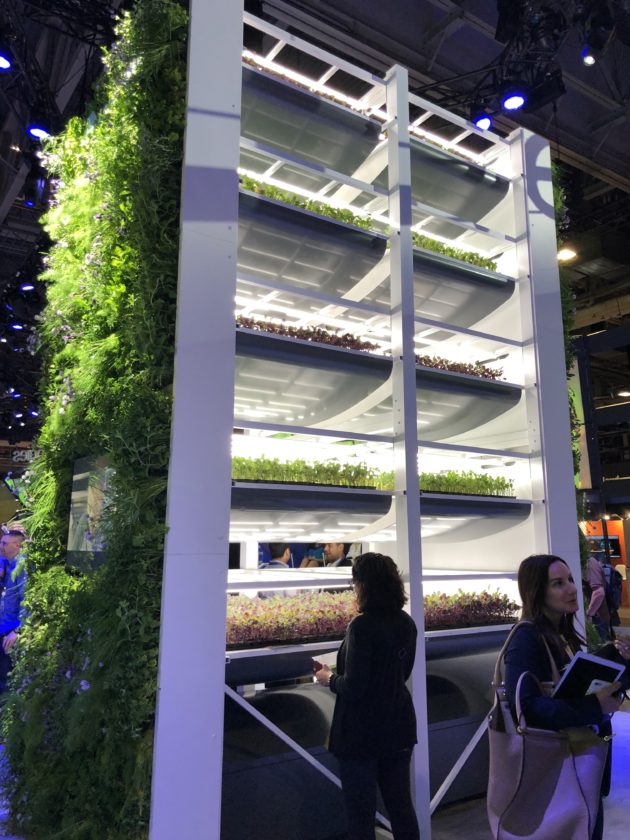
Let me take you on a photo journey through the prominent booth at the DT World Expo floor highlighting a number of projects.
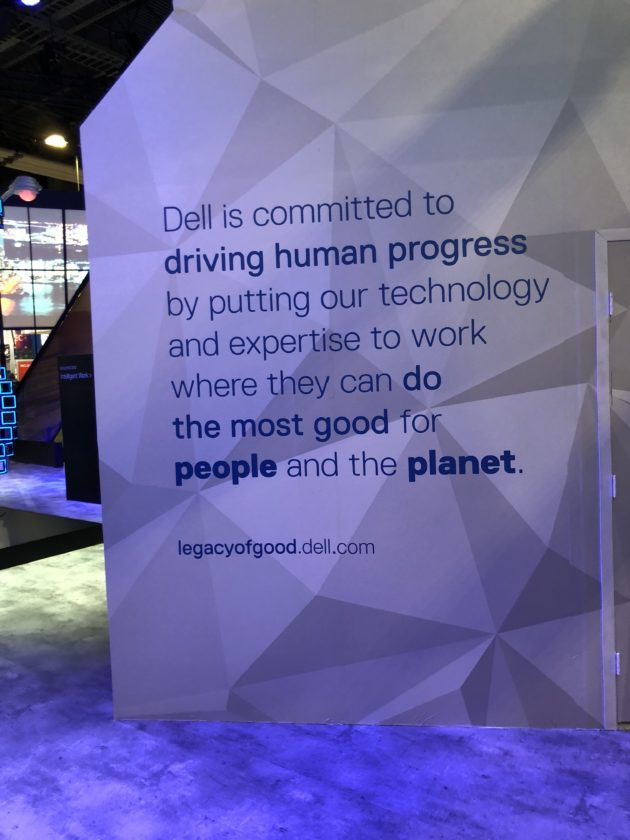
Plastic waste floating in the ocean is fast becoming an environmental catastrophe. Here is someone doing something about it.
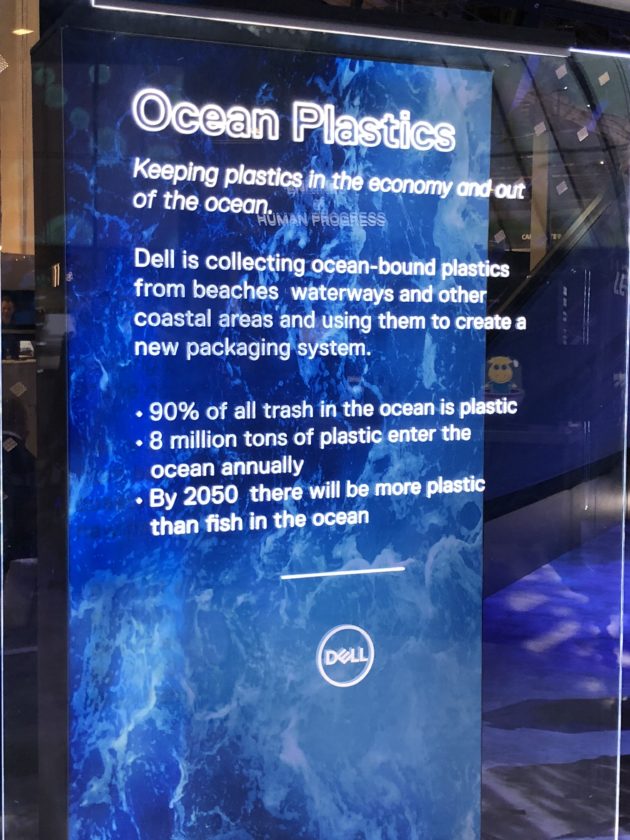
How about genetic mapping improvements for fighting rare diseases?
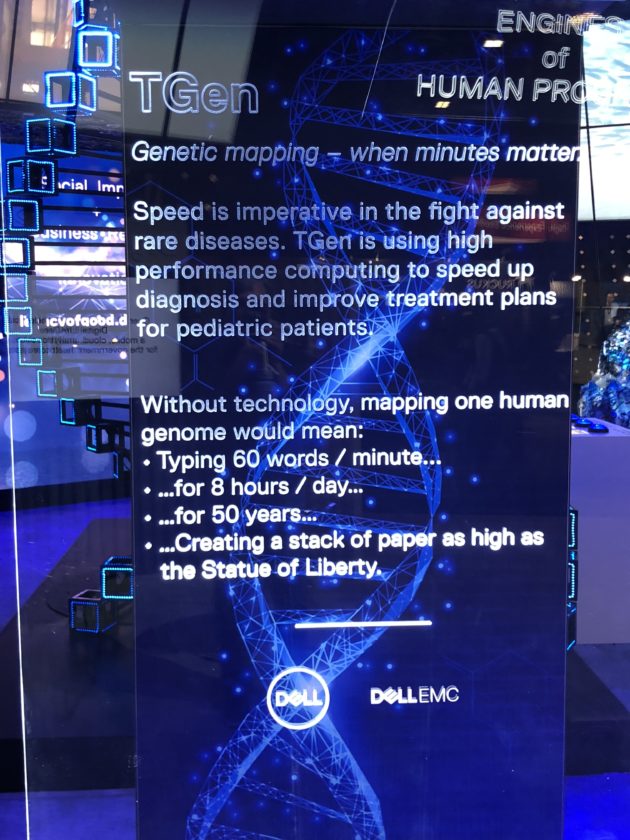
A bug’s eye view with drones to help the honeybee population.
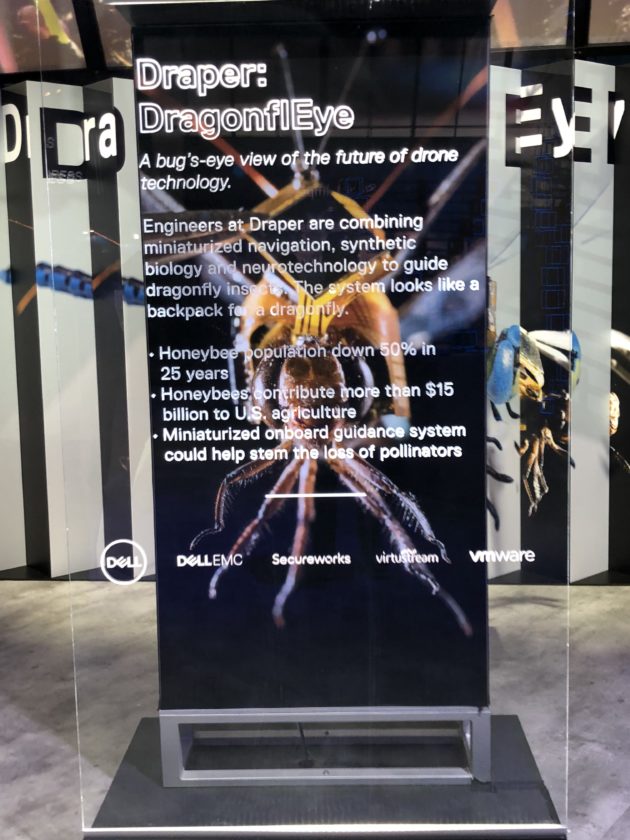
All kinds of wild robot science fiction stories are hitting main-stream media. How about a reality check?
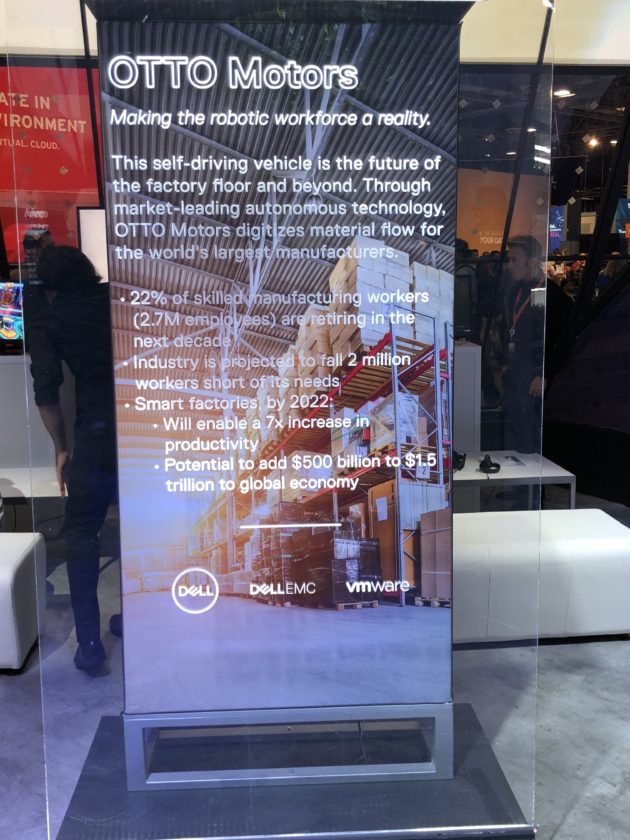
Oh, another main-stream media hype fest–AI. In reality is can be a boost to business not in a scary way.
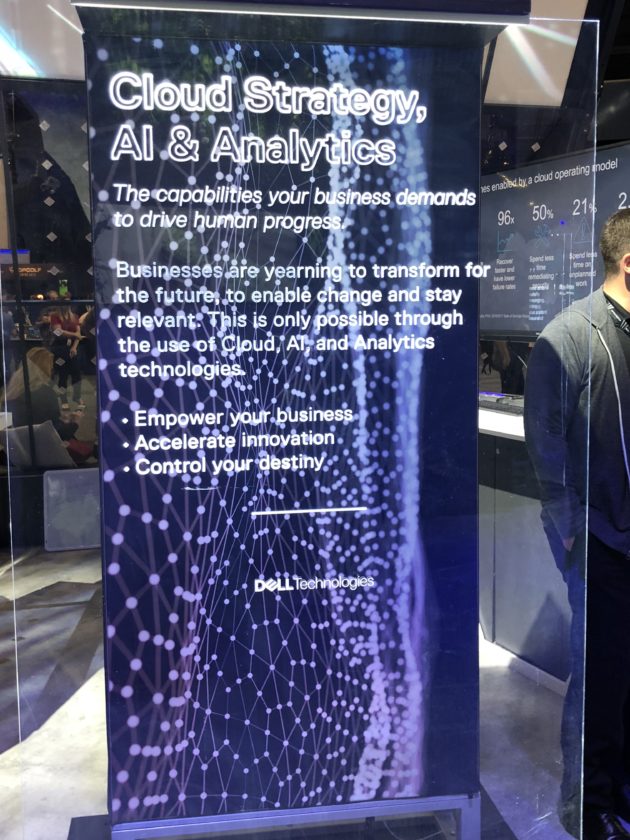
Here is a manufacturing product lifecycle story.
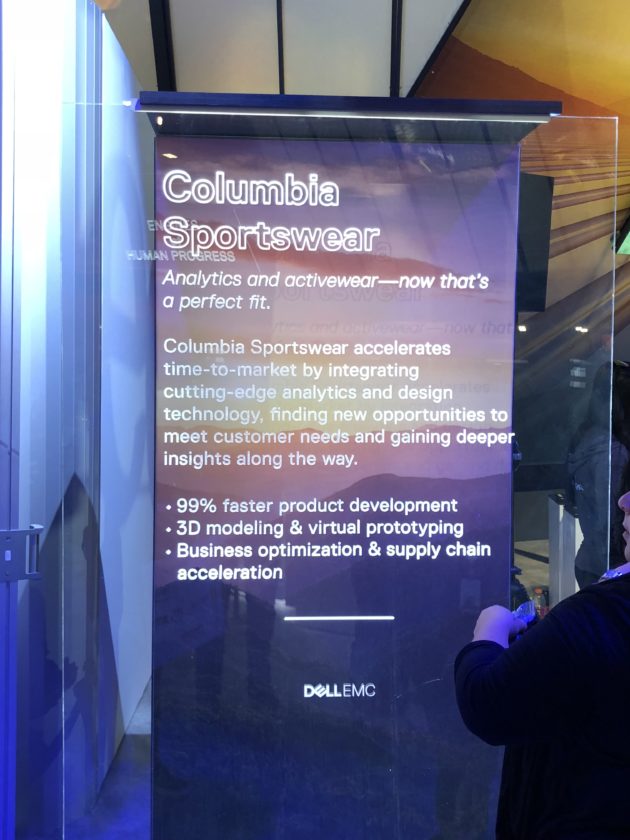
And the AeroFarms story.
